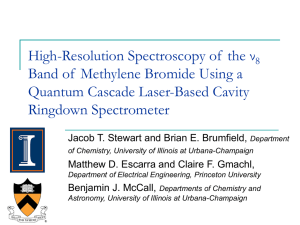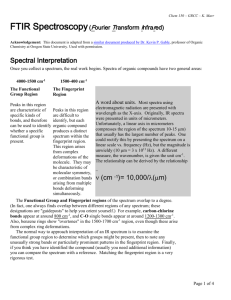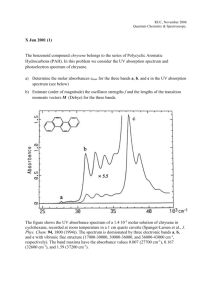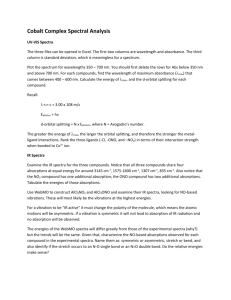A13.08.0010 Supplementary Revised
advertisement
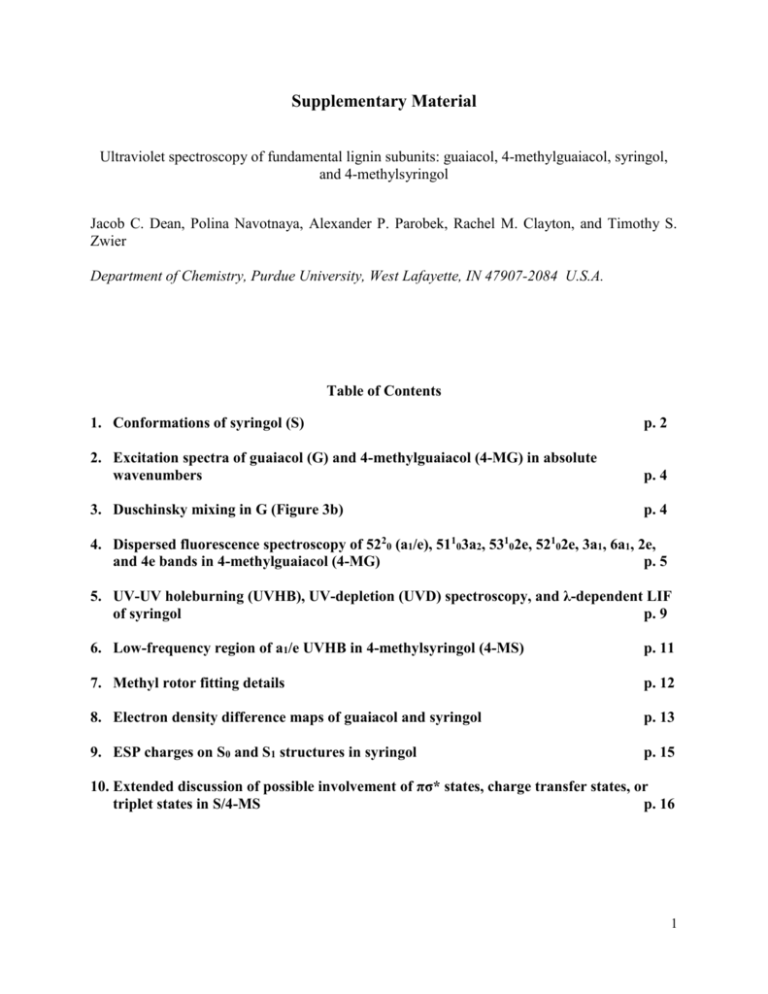
Supplementary Material Ultraviolet spectroscopy of fundamental lignin subunits: guaiacol, 4-methylguaiacol, syringol, and 4-methylsyringol Jacob C. Dean, Polina Navotnaya, Alexander P. Parobek, Rachel M. Clayton, and Timothy S. Zwier Department of Chemistry, Purdue University, West Lafayette, IN 47907-2084 U.S.A. Table of Contents 1. Conformations of syringol (S) p. 2 2. Excitation spectra of guaiacol (G) and 4-methylguaiacol (4-MG) in absolute wavenumbers p. 4 3. Duschinsky mixing in G (Figure 3b) p. 4 4. Dispersed fluorescence spectroscopy of 5220 (a1/e), 51103a2, 53102e, 52102e, 3a1, 6a1, 2e, and 4e bands in 4-methylguaiacol (4-MG) p. 5 5. UV-UV holeburning (UVHB), UV-depletion (UVD) spectroscopy, and λ-dependent LIF of syringol p. 9 6. Low-frequency region of a1/e UVHB in 4-methylsyringol (4-MS) p. 11 7. Methyl rotor fitting details p. 12 8. Electron density difference maps of guaiacol and syringol p. 13 9. ESP charges on S0 and S1 structures in syringol p. 15 10. Extended discussion of possible involvement of πσ* states, charge transfer states, or triplet states in S/4-MS p. 16 1 1. Conformations of syringol (S) The observed conformations of all of the molecules presented (G, S, 4-MG, 4-MS) are consistent with the planar, global minimum structures predicted by density functional theory (DFT) calculated zero-point corrected energies. Local minima associated with non-hydrogen bonded conformers are approximately 20 kJ/mol higher in energy and are not observed experimentally, and no other stable minima exist for G/4-MG. In S however, another conformer is predicted to be only 1.34 kJ/mol above the global minimum. This conformer places the non H-bonded methoxy group 68° away from its planar low-energy conformation along the C(1)C(6)OC(H3) dihedral, forming a weak H-bond between one methoxy CH and the OH oxygen. Figure S1 shows the relaxed potential energy scan along this coordinate calculated at the M05-2X/6-311++G(d,p) level of theory. The local minimum is shown in Figure S1 at ± 68° while 180° is the second equivalent planar minimum. There are two barriers along this coordinate with the larger at approximately ± 120° with a height of ~8 kJ/mol, occurring at a bent orientation that points away from the OH. The smaller barrier at 0° incorporates the methoxy group in plane but toward the OH group. There is no experimental evidence for this local minimum, whose population must be removed by collisional cooling during the supersonic expansion. 2 FIG. S1. Relaxed potential energy scan along the non H-bonded methoxy torsion coordinate C(1)C(6)OC(H3) in S. 3 2. Excitation spectra of guaiacol (G) and 4-methylguaiacol (4-MG) in absolute wavenumbers FIG. S2. (a) LIF excitation spectrum of G with labels of assignments. (b) R2PI spectrum of 4-MG (top) with UVHB spectra of a1 (middle) and e (bottom) methyl rotor with their corresponding assignments. 3. Duschinsky mixing in guaiacol (G) (Figure 3b) The 4420 DFL spectrum of G is shown in Figure 3b, and the prominent bands in the first 700 cm-1 are evidence of substantial Duschinsky mixing among the lowest four a″ modes. The first combination band that appears in the spectrum is 430144204501 with no ν44 character. Surprisingly, the 4422 transition does not appear in the spectrum, counter to the general 4 expectation of large Franck-Condon factors (FCFs) for Δv=0 transitions. The largest bands in this region are the combination bands 43014421, 42014421, 420143014420, and 42024420 around -600 cm-1. These cross-sequence bands signal substantial Duschinsky mixing, so that the 442 level is in actuality an admixture of these ground state modes, revealing these combinations in large intensity in emission. This set of bands was used to determine the absolute S 0 frequencies of these a″ modes, leading to firm assignments of the full set of these vibrations in both S0 and S1 states. 4. Dispersed fluorescence spectroscopy of 5220 (a1/e), 51103a2, 53102e, 52102e, 3a1, 6a1, 2e, and 4e bands in 4-methylguaiacol (4-MG) a) DFL of 5220 (a1/e) in 4-MG The DFL spectra from the 522(0a1) and 522(1e) excited state levels in 4-MG are shown in Figure S3. Coming from the 5220 0a1 level (Figure S3, top), the largest band in the spectrum is the 3a1 band at -70 cm-1, and the pure 6a1 band appears at -190 cm-1. Other smaller bands in the spectrum are combination bands, many of which are evidence for Duschinsky mixing involving the low frequency a″ modes as in G. The first cross-sequence band is the 522053013a2 combination at -130 cm-1, which is a rotor-vibration combination of allowed a′ symmetry. Other active modes of this nature include 522053023a1 and 510152205301. The appearance of these bands again signals Duschinsky mixing between the ν52, ν53, and ν51 modes similar to G (Section 3, Supp. Mat.) with the addition of mixing with the methyl rotation. 5 FIG. S3. DFL spectra in the low-frequency region of the 5220(a1) (top) and 5220(e) (bottom) bands in 4-MG. The DFL spectrum of 5220 originating from the 1e′-level in S1 (Figure S3, bottom) shows considerable activity in the first 400 cm-1. Much of this activity is due to cross-sequence bands similar to the 5220(0a1) spectrum; however, the largest intensity resides in the resonance fluorescence at 5220(1e) which differs from 5220(a1). After this band, the 510152202e combination band displays the largest Franck-Condon factor (FCF) demonstrating significant mixing between ν52 and ν51. The mixing between methyl rotor e-levels is even more dramatic in this spectrum compared to 5220(a1), with a multitude of Franck-Condon active combinations involving the 2e and 4e levels in the ground state. This produces a fair amount of congestion in the lowfrequency region of the spectrum, and the band assignments are presented as labels in Figure S3. Towards lower wavenumber, these spectra become increasingly congested, and the baseline level steadily increases, as shown in Figure S4. This was also observed in the 4420 DFL in G (Figure 3b), which is the analogous φ flapping mode. This verifies the mode-specific nature of this effect in both G and 4-MG. 6 FIG. S4. Extended DFL spectra of 5220(a1) (top) and 5220(e) (bottom) bands in 4-MG. b) DFL of the vibration-rotor bands 51103a2, 53102e, and 52102e in 4-MG DFL of several vibration-methyl rotor combination bands are shown in Figure S5. These spectra aided in the assignment of their corresponding S1 bands, and demonstrate the coupling between methyl rotation and a″ vibrations in both S0 and S1. The 52103a2 band is found just to the red of the 5340 band in the excitation spectrum from the 0a1 level (Figure 2b, blue). Its DFL spectrum shows strong Δv=0 FCFs with a few a1 rotor bands appearing to the blue. The 53102e band (Figure S5, middle) also displays dominant Δv=0 FCFs with the addition of the 51015311 combination. The 52102e combination shows significant Franck-Condon activity similar to the pure 5220(e) band (Figure S3, bottom), with all of the notable bands showing mixed vibration/erotor character (besides the 4e band). As in the 5220 DFL spectra, the vibrations involved are the low-frequency Duschinsky mixed modes. 7 FIG. S5. DFL spectra of the 51103a2, 53102e, 51102e bands in 4-MG. c) Analysis of pure methyl rotor DFL spectra of 4-MG in Figure 6b. The pure 3a1′-3a1″ emission at -70 cm-1 is dominant in the 3a1 DFL spectrum, but combinations involving 3a1 with 5302 and 3501 are also observed with reasonable intensity. Additionally, a band at approximately -130 cm-1 can only be explained as a 53013a2 combination band, yielding an experimental frequency of 57 cm-1 for 3a2″. Similarly, combinations of 6b01 and 101 ring modes are also observed with 3a1. The 6a1′ DFL spectrum of 4-MG yields similar results with large FCFs to 6a1″. There is also appreciable intensity in a 3a2″ combination with one quantum of the oop ν51 mode, from which the fundamental frequency of the latter is determined to be 194 cm-1. The DFL spectrum of the pure e-levels (shown on the right side in Figure 6b) confirm the frequencies for the pure e-rotor levels in the ground state, and also display combinations with 8 oop modes ν53 and ν51, similar to the a1 spectra. The 4e spectrum shows a small 53012e band that appears between the large 4e and 5e bands, with a larger 1e combination with 5101, confirming the frequency assignment for the ν51 fundamental. The form of this mode is a OCH3 methyl torsion coupled with the asymmetric oop motion of the OCH3 oxygen and neighboring aromatic CH. 5. UV-UV holeburning (UVHB), UV-depletion (UVD) spectroscopy, and λ-dependent LIF of syringol To ensure that only a single conformation of syringol was present in the supersonic expansion, UVHB spectroscopy was performed and is shown in Figure S6 (red), where it is compared with the R2PI spectrum (black). The spectra are identical, and the UVHB spectrum faithfully reproduces even the smallest features in the R2PI spectrum. This validates the assignment of the entire spectrum to a single conformation despite the existence of a second low lying minimum (Figure S1). FIG. S6. R2PI (black), UVHB (red), and UVD (blue) spectra of S. The asterisks indicate the holeburn transition used in acquiring the double-resonance spectra. 9 The spatial and temporal setup of the two UV lasers in UVD spectroscopy is equivalent to UVHB; however, in UVD the 20 Hz probe laser is set to the transition labeled by the asterisk in Figure S6, and monitored in active baseline subtraction, as the “holeburn” laser (10 Hz) is scanned. When the holeburn laser is resonant with a transition sharing the same zero-point level in the ground state, depletion is recorded. The novelty in UVD versus UVHB is that it is able to detect transitions that do not emit, as long as they have sufficient oscillator strength and can produce a measurable population change in the ground state level. Thus, UVD will detect resonant transitions even if the transition is “dark” in R2PI/LIF due to non-radiative processes. By contrast, since the probe laser is scanned in UVHB, these “dark” levels will not appear in the UVHB scan as they would in UVD. Thus, the UVD experiment was performed as a test for the presence of non-radiative processes in the R2PI spectrum influencing the measured intensities of transitions where the spectrum cuts off, ~500 cm-1 above the S1 origin. This result is shown in Figure S6 (blue). We see that the UVD spectrum is identical to the R2PI/UVHB spectra except for a lower signal/noise due to shot-to-shot fluctuations in the resonant probe ion signal. The broad, red-shifted emission in S, shown in Figure 9, was observed from the DFL of all of the bands tested. As a test of the wavelength dependence of the fluorescence from bands observed in LIF, a series of wavelength cut-off filters were used to transmit only photons with energies lower than the wavelengths indicated in Figure S7. This method has been used to characterize dual emission in charge-transfer systems by differentiating LIF signals emitting from different electronic states.1-4 Figure S7 shows that regardless of the wavelength of the collected emission, the LIF excitation spectrum remains unchanged. This further validates that all of the observed bands in the excitation spectrum of S are emitting the broad, red-shifted emission reported from the +308 cm-1 band in Figure 9. The minor features in the λ > 280 nm 10 spectrum (middle) that differ from the other two reported spectra are due to residual guaiacol in the expansion. FIG. S7. R2PI spectrum (top) and the LIF spectrum of S using different λ cut-off filters for the collected emission. 6. Low-frequency region of a1/e UVHB in 4-methylsyringol (4-MS) Although much of the 4-MS spectrum was left unassigned due to the spectral congestion brought on by the methyl rotor, some of the lowest methyl rotor bands were assigned and used to determine the S1 methyl rotor potential. The low-frequency region of the UVHB of 4-MS is shown in Figure S8. As shown, the 3a1′-0a1″ and 2e′-1e″ transitions were assigned based on comparison of the two UVHB spectra and the overall isolation of those bands between UVHB spectra (eliminating the possibility that those bands are vibronic bands which appear in both UVHB spectra). The first pure vibronic band was found at +85 cm-1 and is assigned as the fundamental of the nearly localized H-bonded methoxy torsion, τ, which is similar in frequency to the corresponding band in S (+83 cm-1). The predicted S1 geometry is nearly equivalent to the S1 geometry of S, with vibrational frequencies that closely resemble S. The larger number of 11 bands near τ10 in the e-spectrum indicates additional methyl rotor bands allowing for the assignment of the 4e′-1e″ and 5e′-1e″ transitions. FIG. S8. Low frequency region of the a1 (blue) and e (red) UVHB spectra of 4-MS. 7. Methyl rotor fitting details The methyl rotor potentials were simulated using a one-dimensional hindered rotor Hamiltonian with a hindering potential given in equation (2) of the manuscript.5 The reduced rotational constants, F, used in the simulation were calculated using the corresponding DFT//M05-2X/6-311++G(d,p) optimized geometries and are: 4-MG – 5.479 cm-1 (S0)/5.429 cm-1 (S1), 4-MS – 5.448 cm-1 (S0)/5.422 cm-1 (S1). The eigenvalues were generated using a free rotor basis set with 200 basis functions ensuring the appropriate convergence. After the eigenvalues were calculated for a particular set of V3/V6 terms, the frequencies (taken from calculated eigenvalues) of all of the experimentally-determined methyl rotor transitions were compared with experimental frequencies. The barrier parameters were iteratively modulated until the frequency differences were minimized between simulation and experiment. Several sets of 12 iterations were done to check the interdependence of V6 with V3, resulting in only slight changes. After the appropriate V3/V6 values were found both for S0 and S1, the phase shift, Δφ, was determined by comparing the output Franck-Condon factors for each methyl rotor transition to the corresponding experimental intensities. The transitions modeled in the fits were those given in Table II. The errors on V3 and V6 for 4-MG S0, S1, and 4-MS S1 were estimated at: 4-MG - V3″ = 70 ± 4 cm-1, V6″ = -5 ± 8 cm-1, V3′ = 143 ± 8 cm-1, V6′ = 25 ± 12 cm-1; 4-MS - V3′ = 45 ± 5 cm-1, V6′ = -20 ± 12 cm-1. The error was estimated by comparison of the rms deviation between the simulation and experiment to one normal standard deviation of the determined barrier values. 8. Electron density difference maps of guaiacol and syringol In further elucidating the nature of the geometry changes observed for G and S, analysis of the change in electron density between S0 and S1 was performed. The molecular orbitals (MOs) involved in the electronic transition of G and S are shown in Figure 13a and 13b respectively, and were used to generate the total S0 and S1 electron densities for generation of a difference map. These MOs were squared and scaled by their normalized, squared coefficients taken from TDDFT vertical excitation energy calculations (given in Figure 13). The scaled, squared ground state MOs and excited state MOs were then summed separately to give the total S0 and S1 electron densities as shown in Figure S9. The S0 density was then subtracted from the S1 density yielding a map of electron density gain (blue) and loss (gold), shown in Figure S9. 13 FIG. S9. S0 and S1 electron density and electron density difference map (EDDM) for (a) G and (b) S from M052X/6-311++G(d,p) calculations. All surfaces are shown with an isovalue of 0.002. As seen in Figure S9, electron density moves away from the oxygen atoms into the aromatic ring. In G (Figure S9a), a portion of electron density is also lost at C(1) and C(2) (Figure 1), only showing a gain at the C(3)/C(6) positions. The electron density around the aromatic ring in S1 for both molecules shows nodal patterns that manifest in a lengthening of the bonds about the ring as is typical for ππ* transitions of aromatic rings. The transfer of electron density from the oxygen atoms to the ring suggests a loss of conjugation between these groups in S1, partially explaining the loss of planarity in the excited state of both molecules. However, the EDDM of S (Figure S9b) is symmetric about the C(1)-O axis differing from the asymmetric geometry predicted by the same calculation methods. Although the EDDM gives a qualitative picture of the change in electron density between S0 and S1, the electrostatic potential (ESP) atomic charges yield a more quantitative explanation for the apparent asymmetry in the S 1 14 geometry of S (Section V.B.); in fact, some of those results contradict the picture given by the generated EDDMs. 9. ESP charges on S0 and S1 structures in syringol The electrostatic potential fitting charges (ESP) were calculated for S at the M05-2X/6311++G(d,p) level of theory, and are shown in Figure S10. The charges on the CHn groups are displayed as the summed charge (C+ΣH). These results show a distinctly asymmetric charge distribution in the S1 state, which is a reasonable cause for the observed geometry change. FIG. S10. ESP charges for the S0 and S1 geometries of syringol (M05-2X/6-311++G(d,p)). 15 10. Extended discussion of possible involvement of πσ* states, charge transfer states, or triplet states in S/4-MS Section V.C. discusses possible explanations for the broad, red-shifted emission observed in S and 4-MS. Nonadiabatic coupling to nearby excited states was briefly discussed, with particular emphasis on πσ* states which are known to be involved in photochemical processes in substituted phenols.6-8 These states were found in vertical excitation energy calculations of S for the O-H and O-CH3 bonds respectively (Table IV). Here we amplify this discussion, and extend the types of states considered to include charge transfer and triplet states as possibilities. Using the EOM-CCSD energies in Table IV and scaling the wavenumber position of the bright state (S0-S1) to the experimental origin of syringol, the vertical separation between the S 1 and S2/S3 states at the ground state geometry is approximately 2300/4900 cm-1. This is well above the observable transitions in the S0-S1 region, but it is still possible for the OH to tunnel underneath the conical intersection directly onto the πσ* surface. Experiments addressing the location and role of these πσ* states in S will be reported in later work. Several experiments were performed on S in order to test the nature of the excited state processes giving rise to the shifted and broadened emission, and the possibility of non-adiabatic coupling to a dark electronic state (such as πσ*). First, UV-depletion (UVD) spectroscopy was used to test for the presence of a non-radiative threshold, as was briefly discussed in Section V.C. UVD monitors an emissive upper state with the probe laser as the hole-burn laser is tuned. Any absorption induced by the hole-burn laser appears as a depletion signal, resulting in a spectrum that more faithfully reproduces the pure absorption spectrum. The detailed results of this experiment can be found in Section 5. The spectrum (Figure S6) was identical to the R2PI/UVHB spectrum, indicating that if non-radiative processes distort the Franck-Condon profile, they do not do so in first 600-700 cm-1 above the S1 origin. 16 To eliminate the possibility that the broad emission was an outcome of fast intersystem crossing to a triplet manifold followed by phosphorescence, the DFL spectrum was taken by gating the iCCD over the first 15 ns of the emission, ensuring no long-lived emission (phosphorescence) was collected. The spectrum was still structureless and red-shifted, arguing against triplet state contributions. The possible participation of charge transfer states typically occurs in molecules with well-defined electron donor and acceptor units, a circumstance that is not met by the present case with its three oxygen-containing substituents. Intramolecular charge transfer often occurs via a “locally” excited (LE) state carrying the majority of the oscillator strength coupling to a chargetransfer (CT) state along a well-defined coordinate (such as a side chain twist or ring deformation), with dual fluorescence observed that reflects the identity of the emitting state in the emission profile.1-4 Previous studies have shown that direct absorption to a CT state will likely be broad and structureless, much like its emission.4 Mediation via a LE state would seem necessary to account for observation in S, since the absorption spectrum is sharp; however, the calculations we have carried out do not predict a CT state near the ππ* state. References 1 2 3 4 5 6 7 S. Cogan, S. Zilberg, and Y. Haas, J. Am. Chem. Soc. 128 (10), 3335 (2006). A. J. Fleisher, R. G. Bird, D. P. Zaleski, B. H. Pate, and D. W. Pratt, J. Phys. Chem. B 117 (16), 4231 (2013). D. Schweke, H. Baumgarten, Y. Haas, W. Rettig, and B. Dick, J. Phys. Chem. A 109 (4), 576 (2005). N. A. Vandantzig, H. S. Shou, J. C. Alfano, N. C. C. Yang, and D. H. Levy, J. Chem. Phys. 100 (10), 7068 (1994). J. D. Lewis, T. B. Malloy, T. H. Chao, and J. Laane, J. Mol. Struct. 12 (3), 427 (1972). T. N. V. Karsili, A. M. Wenge, S. J. Harris, D. Murdock, J. N. Harvey, R. N. Dixon, and M. N. R. Ashfold, Chem. Sci. 4 (6), 2434 (2013). G. A. King, T. A. A. Oliver, R. N. Dixon, and M. N. R. Ashfold, Phys. Chem. Chem. Phys. 14 (10), 3338 (2012). 17 8 D. J. Hadden, G. M. Roberts, T. N. V. Karsili, M. N. R. Ashfold, and V. G. Stavros, Phys. Chem. Chem. Phys. 14 (38), 13415 (2012). 18


